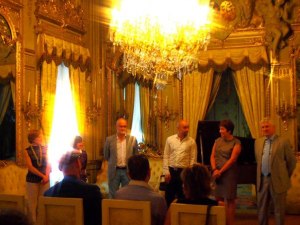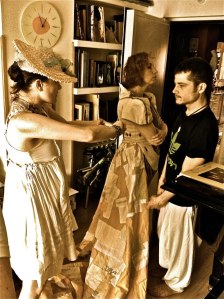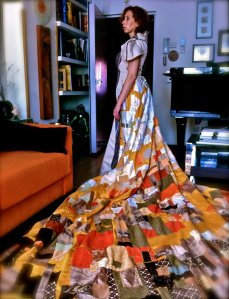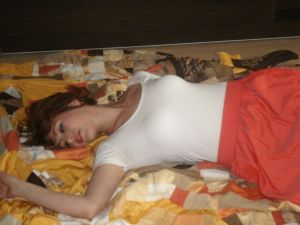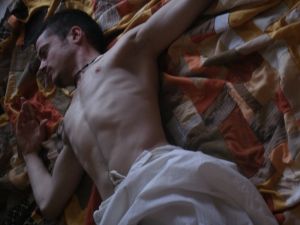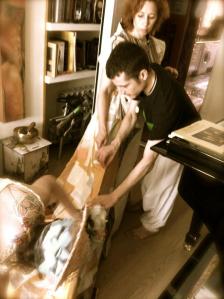September 8, 2012
by Anna Tonna
One of the Gustav Klimt’s most well-known painting is inspired in Greek mythology, an unusual theme within the body of work by this Viennese painter.
Danae was Acrisio´s daughter; the Oracle prophesized that Danae´s son was to kill King Acrisio and for this, the King locked her in a bronze tower under the watchful eye of an old woman. Acrisio, however, was not able to prevent Danae from being seduced by Zeus, who came to her as a shower of gold and engendered the undesired son. The newborn child would be named Perseus; he was to become the legendary founder of Mycenae and of the Perseid dynasty of Danaans. He was the first of the heroes of Greek mythology whose exploits include defeating various archaic monsters, which in turn provided the founding myths of the Twelve Olympians.
This painting is a typical representation of Klimt’s stylized eroticism, and portrays the subject of Danae, a popular theme in the history of painting and essayed by Correggio, Rembrandt, and Titian.

Danae, 1530, Corregio
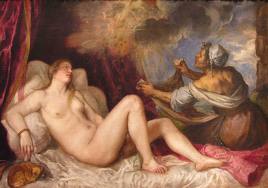
Danae and the shower of gold, 1554, Titian
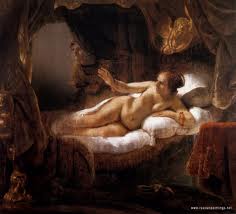
Danae, 1636, Rembrandt
Danae is seen as a symbol of divine love, transcendence, and sensual beauty.
Klimt avoided the classical references of the Renaissance and Baroque by presenting us a young and completely isolated Danae, without spatial reference, surrounded by decorative and sumptuous clothes that frame her curvaceous body. The position of Klimt’s Danae accentuates the feeling of eroticism, with its rounded shapes; the usage of golden color increases and accentuates the idea of the female nude as a decorative object; meanwhile, her eyes are closed, her lips slightly parted, and the girl definitely looks aroused. By positioning the model with a raised leg, this painting pays tribute to Titian’s series of paintings of the same name; in my recreation of this hallmark painting for the performance of KLIMT: Artist of the Soul, this was an element that I sought to preserve in my recreation based on the painting by Klimt. The chromaticism of Klimt is absolutely inimitable; his use of golden backgrounds is a famous characteristics and look that has made his paintings well known world wide. Because of this, I avoided using these elements in my drawings, looking for a new eroticism based on the contrast among textures and different light points.
The use of the colors black, white and red is a constant that I will keep in all of the drawings related to KLIMT: Artist of the Soul; this aesthetic choice has its origin in a monologue from the play “Salome” by Oscar Wilde which I quote below:
“I am amorous of thy body, Iokanaan! Thy body is white, like the lilies of the field that the mower hath never mowed. Thy body is white like the snows that lie on the mountains of Judaea, and come down into the valleys. The roses in the gardens of the Queen of Arabia are not snow white as thy body. Neither the roses in the garden of the Queen of Arabia, the garden of spices of the Queen of Arabia, nor the feet of the dawn when they light on the leaves, nor the breast of the moon when she lies on the breast of the sea. There is nothing in this world so white as thy body (…)
It is of thy hair I am enamoured, Iokanaan. Thy hair is like clusters of grapes, like the clusters of black grapes that hang from the vine-trees of Edom in the land of the Edomites. Thy hair is like the cedars of Lebanon, like the great cedars of Lebanon that give their shade to the lions and to the robbers who would hide them by day. The long black nights, when the moon hides her face, when the stars are afraid, are not so black as thy hair (…)
It is thy mouth that I desire, Iokanaan. Thy mouth is like a band of scarlet on a tower of ivory. It is like a pomegranate cut in twain with a knife of ivory. The pomegranate flowers that blossom in the gardens of Tyre, and are redder than roses, are not so red. The red blasts of trumpets that herald the approach of kings, and make afraid the enemy are not so red. Thy mouth is redder than the feet of those who tread the wine in the wine-press. It is redder than the feet of the doves who inhabit the temples and are fed by the priests. It is redder than the feet of him who commeth from a forest where he hath slain a lion, and seen gilded tigers. Thy mouth is like a branch of coral that fishers have found in the twilight of the sea, the coral that they keep for the kings! It is like the vermilion that the Moabites find in the mines of Moab, the vermilion that the kings take from them. It is like the bow of the King of the Persians, that is tainted with vermilion, and is tipped with coral. There is nothing in the world so red as thy mouth. Suffer me to kiss thy mouth. I will kiss thy mouth, Iokanaan. I will kiss thy mouth.”

Danae, 1907, Klimt

Danae, 2012 Patricia de Andrés (unfinished)
Una de las más famosas obras de Klimt se halla inspirada en la mitología griega, una temática muy inusual en las creaciones del pintor vienés.
Dánae era hija del rey Acrisio. El Oráculo había anunciado que el hijo de Dánae mataría al rey, por eso, Acrisio la encerró en el interior de una torre de bronce bajo la vigilancia de una anciana. Sin embargo no pudo ser capaz de evitar que Dánae fuera seducida por Zeus el cual, bajo la forma de una lluvia dorada engendró al hijo no deseado. El recién nacido se llamaría Perseo, el legendario fundador de Micenas y de la dinastía de las Perseidas. Fue uno de los primeros héroes documentados de la mitología griega cuyas hazañas relativas a las derrotas de varios monstruos ancestrales contribuyeron al establecimiento de los mitos sobre los Doce Olímpicos.
Esta pintura corresponde con una representación típica del estilizado erotismo de las obras de Klimt e ilustra el tema de Dánae el cual ha sido recurrente a lo largo de la historia de la pintura, habiendo sido tratado antes por maestros como Correggio, Rembrandt y Tiziano.
Dánae es el símbolo del amor divino, de la trascendencia y de la belleza sensual. Klimt evitó las referencias clásicas del Renacimiento y Barroco presentándonos a la joven Dánae completamente aislada, sin ninguna referencia espacial, rodeada de decorativas y suntuosas telas que enmarcan su curvilíneo cuerpo.
La postura de Dánae acentúa el erotismo y las formas redondeadas y el color dorado ayuda a incrementarlo convirtiendo de esta manera el desnudo femenino en un objeto decorativo. Mientras que sus ojos están cerrados sus labios se abren ligeramente mostrándola completamente extasiada.
Posicionándola con la pierna levantada, esta pintura hace homenaje a la serie de pinturas de Tiziano sobre este mismo tema y es un elemento que quise conservar en mi recreación de la obra original de Klimt.
El cromatismo de Klimt es absolutamente inimitable, el uso de sus fondos dorados es una de sus más relevantes características que lo han hecho mundialmente reconocido, por eso evité el uso de estos elementos en mis dibujos, buscando una nueva interpretación de ese mismo erotismo basada en el contraste de texturas y de juegos de sombras logrados con diferentes puntos de luz.
El uso de los colores negro, blanco y rojo es una constante que estoy manteniendo en todas las ilustraciones de este proyecto y tiene su origen en un monólogo de la “Salomé” de Oscar Wilde:
“¡Iokanaán! Estoy enamorada de tu cuerpo. Tu cuerpo es blanco como el lirio de un prado que nunca fue segado. Tu cuerpo es blanco como las nieves que reposan en las montañas, como las nieves que reposan en las montañas de Judea y descienden a los valles. Las rosas del jardín de la reina de Arabia no son tan blancas como tu cuerpo. Ni las rosas del jardín de la reina de Arabia, del jardín perfumado de la reina de Arabia, ni los pies de la aurora que caminan sobre las hojas, ni el seno de la luna cuando reposa en el seno del mar… Nada en el mundo es tan blanco como tu cuerpo (…)
Son tus cabellos la causa de mi amor, Iokanaán. Tus cabellos parecidos a racimos de uvas negras de las viñas de Edom, en el país de los edomitas. Tus cabellos son como los cedros del Líbano, como los grandes cedros del Líbano que dan sombra a los leones y a los malhechores que quieren ocultarse durante el día. Las largas noches negras, las noches sin luna, las noches en que las estrellas se ocultan temerosas, no son tan negras como tus cabellos. Nada en el mundo es tan negro como tus cabellos (… )
Es tu boca la causa de mi amor, Iokanaán. Tu boca es como una cinta escarlata sobre una torre de marfil. Como una granada cortada por un cuchillo de marfil. Las granadas que florecen en los jardines de Tiro y son más rojas que las rosas no son tan rojas como tu boca. El rojo griterío de las trompetas que anuncian la llegada de los reyes y amedrantan al enemigo no es tan rojo como tu boca. Tu boca es más roja que los pies de los que pisan el vino en los lagares. Es más roja que los pies de las palomas que habitan en los templos y son alimentadas por los sacerdotes. Es más roja que los pies del hombre que viene de un bosque donde ha dado muerte a un león y ha visto tigres dorados. Tu boca es como una rama de coral que han
hallado unos pescadores en el crepúsculo marítimo y que reservan para los reyes. Tu boca es como el bermellón que los moabitas encuentran en las minas de Moab y que les es arrebatado por los reyes. Tu boca es como el arco del rey de los persas, pintado de bermellón y con cuernos de coral. Nada en el mundo es tan rojo como tu boca… Déjame besar tu boca.”

